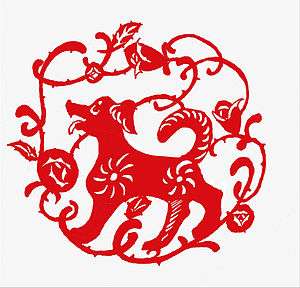Papercutting

Papercutting or paper cutting is the art of cutting paper designs. The art has evolved uniquely all over the world to adapt to different cultural styles.
History

The oldest surviving paper cut out is a symmetrical circle from the 6th century Six Dynasties period found in Xinjiang China.[1][2] Papercutting continued to be practiced during the Song and Tang Dynasties as a popular form of decorative art.[2]
By the eighth or ninth century papercutting appeared in West Asia and in Turkey in the 16th century. Within a century, papercutting was being done in most of middle Europe (see also scherenschnitte and silhouette).
Chinese

Jianzhi (剪紙), is a traditional style of papercutting in China. Jianzhi has been practiced in China since at least the 6th century A.D. Jianzhi has a number of distinct uses in Chinese culture, almost all of which are for health, prosperity or decorative purposes. Red is the most commonly used color. Jianzhi cuttings often have a heavy emphasis on Chinese characters symbolizing the Chinese zodiac animals.
Although paper cutting is popular around the globe, only the Chinese paper cut was listed in the UNESCO Intangible Cultural Heritage Lists, which was in 2009.[3] The Chinese paper-cutting was recognized and listed because it has a history of more than 1500 years and it represents cultural values of the people throughout China.
Modern paper cutting has developed into a commercial industry. Papercutting remains popular in contemporary China, especially during special events like the Chinese New Year or weddings.[4]
Indonesian
Indonesian traditional art has been influenced by traditional Chinese Artisans. Batik is an Indonesian traditional art and paper cutting. Batik is framed in profile to expose the intricate detail of Batik.
Filipino
Several Philippine crafts employ paper cutting. During Filipino Christmas, the parol (a traditional star-shaped lantern) is embellished with coloured paper cut into various forms such as floral designs on the faces, pom-pons and "tails" on the points of the star.
There is also the art of pabalát (wrapper), where coloured paper is meticulously cut with small scissors and used to sheathe pastillas de leche (carabao milk candy) and other traditional sweets. Paper cutting is also involved in the creation of banderitas (bunting) that feature prominently in fiesta décor; these may be elaborate or plain-cut paper squares and triangles strung over streets.
Indian
Sanjhi is the Indian art of paper cutting. The cut paper is usually placed on the floor and colors are filled in to make Rangoli.
Jewish

Papercutting has been a common Jewish art form since the Middle Ages, connected with various customs and ceremonies, and associated with holidays and family life. Paper cuts often decorated ketubot (marriage contracts), Mizrahs, and for ornaments on festive occasions. A story tells of Rabbi Shem-Tov ben Yitzhak ben Ardutiel, finding that his ink had frozen, continued to write the manuscript by cutting the letters into the paper. By about the 17th century, papercutting had become a popular form for small religious artifacts such as Mizrachs and Shavuot decorations. In the 20th century, the art of Jewish papercutting was revived in Israel. Today it is most commonly used for mizrachs and ketubot.
Mexican
Papel picado is the Mexican art of paper cutting. Tissue paper is cut into intricate designs with scissors or small, sharp chisels; this technique is frequently used to produce decorative banners.
Swedish
Christmas is when flowers of cut and manipulated paper, fringed candy holders called crackers,[5] and Ljuskrona which are covered with cut paper, are found in Swedish and Swedish-American homes.
Switzerland
There is a Swiss tradition of paper-cutting, especially in the Pays-d'Enhaut.
Other
Silhouette can refer to the art of cutting outlines or portraits out of black paper. Modern-day papercutters typically follow one or more of the "traditional" styles listed above, while others have begun to expand the art into new styles, motifs, and designs. Contemporary papercutting is also sometimes associated with the art of stenciling, itself being derived from techniques used in graffiti art. The use of hand-cut stencils in graffiti art has received international attention in recent years due in part to the artist Banksy.
Notable papercut artists
- Joanna Koerten (1650–1715) Dutch artist skilled in Silhouette work.
- Adele Schopenhauer (1797-1849) German author and artist and sister of the philosopher Arthur Schopenhauer
- Hans Christian Andersen (1805–1875) Danish author also known for papercut artwork.
- Henry Matisse (1869-1954) is a French artist, who explored the use of paper-cut illustration and decoupage.
- Lotte Reiniger (1899–1981), maker of Silhouette films.
- Jad Fair (born 1954) is an American artist and musician.
- Jeanette Kuvin Oren (born 1961) American papercut artist
- Peter Callesen (born 1967) is a Danish artist and author.
- Kara Walker (born 1969), a contemporary African American artist.
- Lane Twitchell (born 1967), a contemporary American Landscape artist.
- Nahoko Kojima (born 1981), professional contemporary Japanese Paper Cut Artist. Pioneered sculptural Paper Cuts hanging in 3d.
- Nikki McClure, American papercut artist
- William Schaff (born 1973) is an American artist from Warren, Rhode Island. His original paper cutting was used for the cover of the album "I am Very Far" by Okkervil River.
- Rob Ryan is a British artist known for his papercutting and screen-printing.
- Hina Aoyama is a Japanese artist resident in France.
See also
| Wikimedia Commons has media related to Paper cutting. |
- Chad (paper), left over fragments from cutting.
- Chinese paper folding
- Chinese paper cutting
- Scherenschnitte
- Silhouette
- Vytynanky (Wycinanki)
Notes
- ↑ Needham, Joseph. Chemistry and Chemical Technology. [1974] (1974). Cambridge University Press. ISBN 0-521-08690-6
- 1 2 Michael Sullivan; Franklin D. Murphy (1996). Art and Artists of Twentieth-Century China. University of California Press. p. 150. ISBN 978-0-520-07556-6.
- ↑ "Chinese paper-cut". UNESCO. Retrieved 16 October 2011.
- ↑ "Paper Cutting". Folklore: An Encyclopedia of Beliefs, Customs, Tales, Music, and Art. ABC-CLIO. 2011. p. 285. ISBN 978-1-59884-241-8.
- ↑ Astrim, Catarina Lundgren,. Swedish Christmas in America. ISBN 978-9178431779.
| ||||||||||||||||||||||||||||||